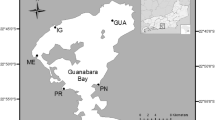Abstract
Cyanide and heavy metals were accidentally released from a mine waste lagoon in Romania into tributaries ultimately draining into the Tisza River. Within two months of the cyanide accident two subsequent heavy metal waste spills further contaminated the Tisza River, followed by severe spring flooding, which potentially spread the contamination to soils adjacent to the river. Flood plain soils and shoreline sediments were sampled from two locations on the middle Tisza River and a reference site to conduct a preliminary assessment of metal content and toxicity. Ten-day sediment toxicity tests were conducted with the amphipod,Hyalella azteca and 24 h soil toxicity tests were conducted with the nematode (Caenorhabditis elegans). High concentrations of cadmium, copper, zinc, lead and arsenic were detected in soil and sediment samples. However, no mortality was observed inHyalella exposed to Tisza River sediments and only up to 27% mortality of C.elegans was observed in flood plain soils. Low mortalities are attributed to reduced metal bioavailability caused by high soil cation exchange capacities and possible interactions with sediment organic matter or sulfides. Future studies should focus on factors that alter metal bioavailability and their relationship to potential toxicity of organisms exposed to Tisza River sediments and flood plain soils.
Similar content being viewed by others
References
Ankley GT (1996): Evaluation of metal/acid volatile sulfide relationships in the prediction of metal bioaccumulation by benthic macroinvertebrates. Environ Toxicol Chem15, 2138–2146
ASTM (1995): Standard test methods for measuring the toxicity of sediment-associated contaminants with freshwater invertebrates. ASTM E 1706-95b. American Society for Testing and Materials, West Conshohocken, PA, USA
ASTM (2002): Standard guide for conducting laboratory soil toxicity tests with the nematodcCaenorhabditis elegans. American Society for Testing and Materials, West Conshohocken, PA, USA (in press)
Baia Mare Task Force (BMTF) (2000): Report of the international task force for assessing the Baia Mare incident. December 2000 (http://europa.eu.int/comm/environment/enlarg/home.htm)
Black CA (Ed) (1965): Methods of Soil Analysis, Part 2: Chemical and Microbiological Properties. American Society of Agronomy, Inc., Madison, WS, USA, pp 920–925
Boyd WA, Stringer VA, Williams PL (2001): Metal LC50s of a soil nematode compared to published earthworm data. In: Greenberg BM, Hull RN, Roberts MH, Gensemer RW (Eds) Environmental Toxicology and Risk Assessment: Science, Policy, and Standardization — Implications for Environmental Decisions. Volume 10, ASTM STP 1403. American Society for Testing and Materials. West Conshohocken, PA, USA, pp. 223–235
DiToro DM, Mahony JD, Hanson, DJ, Scott, KJ, Hicks MB, Redmond MS (1990): Toxicity of cadmium in sediments: The role of acid volatile sulfide. Environ Toxicol Chem 9, 1489–1504
Finlayson B, Fujimuraa R, Huang Z-Z (2000): Toxicity of metal contaminated sediments from Keswick Reservoir, California, USA. Environ Toxicol Chem 19, 285–494
Förstner U (1990): Inorganic sediment chemistry and elemental speciation. In: Baudo R, Giesy J, Muntau H (Eds) Chemistry and Toxicity of In-Place Pollutants Lewis Publishers, Boca Raton FL, USA, pp 61–106
Förstner U, Müller G (1981): Concentrations of heavy metals and polycyclic aromatic hydrocarbons in river sediments: Geochemical background, man’s influence and environmental impact. Geojournal 5, 417–432
Freeman MN, Peredney CL, Williams PL (1999): A soil bioassay using the nematodeCaenorhabditis elegans. In: Henshel DS, Black MC, Harrass MC (Eds) Environmental Toxicology and Risk Assessment: Standardization of Biomarkers for Endocrine Disruption and Environmental Assessment. Vol 8, ASTM STP 1364. American Society for Testing and Materials. West Conshohocken, PA, USA, pp 305–318
Hesse PR (Ed) (1972): A Textbook of Soil Chemical Analysis. Chemical Publishing Company, Inc. New York, NY, USA, pp 91–105
Horwitz W (Ed) (2000): Official Methods of Analysis of AOAC International. 17th Edition. AOAC International. Gaithersburg, MD, USA
Ingersol CG, Haverland PS, Brunson EL, Canfield TJ, Dwyer FJ, Henke CE, Kemble NE (1996): Calculation and evaluation of sediment effect concentrations for the amphipodHyalella azteca and the midge Chironomous riparius. J Great Lakes Res 22, 602–623
Ingersol CG, Nelson MK (1990): Testing sediment toxicity withHyalella azteca (Amphipoda) andChironomus riparius (Dip-tera). In: Landis WG, van Der Schalie WH (Eds) Aquatic Toxicology and Risk Assessment: Vol 13, ASTM STP 1096. American Society for Testing and Materials. West Conshohocken, PA, USA, pp 93–107
Janssen R, Peijnenburg W, Posthuma L, Van Den Hoop M (1997a): Equilibrium partitioning of heavy metals in Dutch field soils. II. Prediction of metal accumulation in earthworms. Environ Toxocol Chem 16, 2470–2478
Janssen R, Posthuma L, Baerselman R, Hollander H, Van Veen R, Peijnenburg W (1997b) Equilibrium partitioning of heavy metals in Dutch field soils. I. Relationship between metal partition coefficients and soil characteristics. Environ Toxocol Chem 16, 2479–2488
Kiss T, Jori Z, Mezosi G, Barta K (2000): Heavy metal pollution of sediments along the River Tisza due to cyanide pollution. Prague 2000, Proceedings of the Fifth International Symposium and Exhibition on Environmental Contamination in Central and Eastern Europe. DOE/EM-0584: 420
Lock K, Janssen J, De Coen W (2000): Multivariate test designs to assess the influence of zinc and cadmium bioavailability in soils on the toxicity ofEnchytraeus albidus. Environ Toxocol Chem 19, 2666–2671
Mahony JD, DiToro DM, Gonzalez AM, Curto M, Dilg M, De Rosa LD, Sparrow LA (1996): Partitioning of metals to sediment organic carbon. Environ Toxocol Chem 15, 2187–2197
Martin C (2000): Heavy metal trends in flood plain sediments and valley fill, River Lahn, Germany. Catena 39, 53–68
Nebecker AV, Miller CE (1988): Use of the amphipod crustaceanHyalella azteca in freshwater and estuarine sediment toxicity tests. Environ Toxicol Chem 7:1027–1033
Peredney CL, Williams PL (2000): Utility ofCaenorhabditis elegans for assessing heavy metal contamination in artificial soil. Arch Environ Contam Toxicol 39, 113–118
USEPA (2000): Methods for measuring the toxicity and bioaccumulation of sediment-associated contaminants with freshwater invertebrates, Second Ed. EPA 600/R-99/064, US Environmental Protection Agency, Duluth MN, USA
Author information
Authors and Affiliations
Corresponding author
Rights and permissions
About this article
Cite this article
Black, M.C., Williams, P.L. Preliminary assessment of metal toxicity in the middle tisza river (Hungary) flood plain. J Soils & Sediments 1, 213–216 (2001). https://doi.org/10.1007/BF02987727
Received:
Accepted:
Issue Date:
DOI: https://doi.org/10.1007/BF02987727




